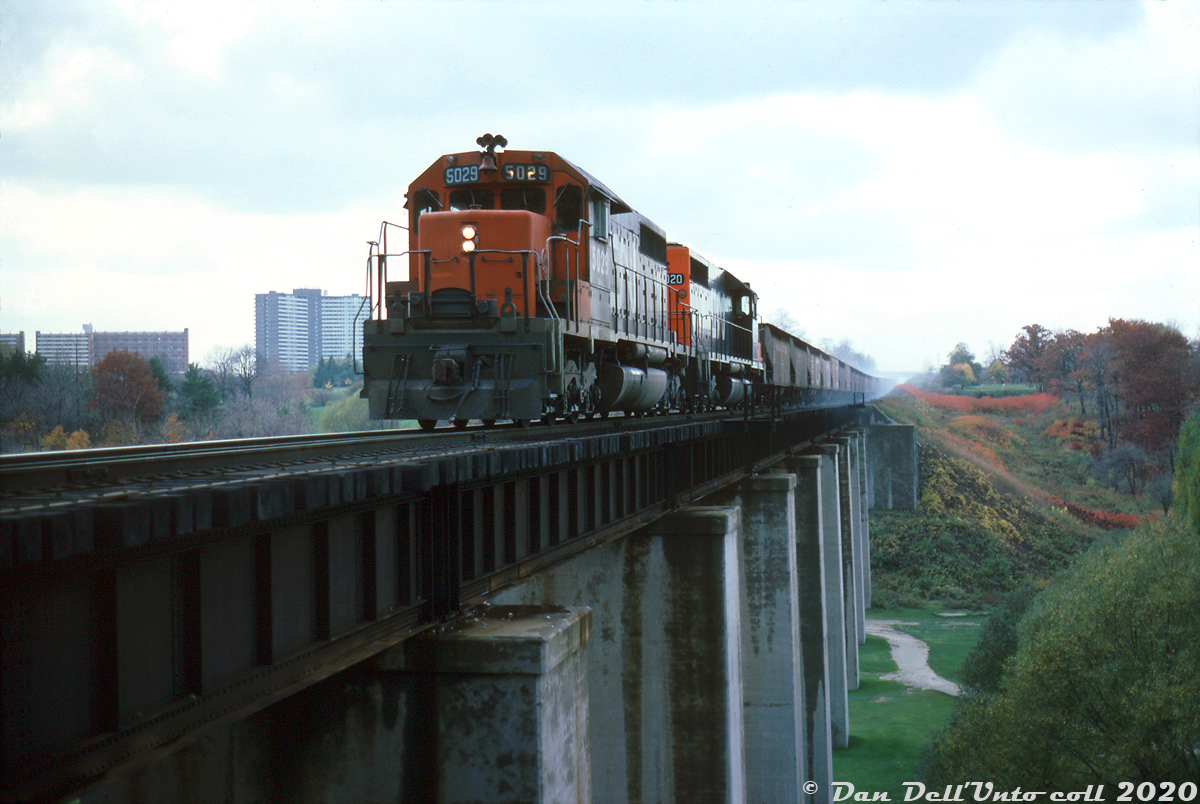|
Caption: With a cloud of blue smoke kicking up from the brakeshoes of trailing hoppers, CN SD40 units 5029 and 5020 lead an eastbound on the descent downgrade between Rexdale and Weston on the Weston Sub, crossing over the high bridge spanning the Humber River just outside of Weston. This is possibly the "Limehouse Turn", coming from the Indusmin quarry on the Guelph Sub near Acton. The crew didn't get the benefit of dynamic brakes with these units, but timetables state that from Halwest to West Toronto (eastbound) a single 5000-series SD40 was good for 6450 tons. Westbound, factoring in the ruling grade up to Rexdale, the tonnage rating was cut to only 3600 tons per SD40.
In the background, one can see some of the apartment buildings off Islington Avenue north of Dixon, and Islington overpass off in the distance. This single-track bridge over the Humber River at Mile 9.4 (formerly "CN McGill") was built by the Grand Trunk Railway in the 1850's when the line was originally constructed as the Brampton Sub (becoming the Weston Sub in 1965). It also spanned over part of the Weston Golf & Country Club's course below, who had a private grade crossing to the west for golf carts. GO Transit purchased the Weston Sub from CN in 2009, and in 2012-2013 the abutments here were expanded and new spans were added to quad-track the bridge (4 mainline tracks!) for increased GO and UPX passenger train service over the line (click here for a present-day image of the line by Michael Da Costa showing the bridge in the background).
Barry Schroeder photo, Dan Dell'Unto slide collection
|



This is nice. So Limehouse was serviced by a dedicated train. Any idea how often and where it’s destination was?
This bridge looks like it may have been retrofit, I’m not sure they used concrete like that in 1856 – most were made of stone abutments.
That’s what I originally thought Steve, but all early photos of it show concrete, including this one from 1860: http://collections.musee-mccord.qc.ca/scripts/viewobject.php?Lang=1§ion=false&accessnumber=N-0000.193.289.1&imageID=308179&pageMulti=1
Jacob: not sure, I’ve seen a few photos of a similar looking “Limehouse Turn” crossing West Toronto diamond in the 70′s, so figure this might be it.
I’m impressed/surprised they went with concrete. The limestone was a trademark of the GTR.
Might have been concrete was easier to use in Toronto but in the country/bush of rural Ontario limestone was easier
i’m not sure when concrete was of generally available use in Ontario given all the limestone used in Guelph for our buildings, it seems to have been exotic in the 1850′s and 60′s
Great picture that brings back a lot of memories for me. I had one trip on this train, numbered 850 at the time. We started and ended at Bathurst Street with power from Spadina in the form of 4 lay over passenger units (6534-4131-4151-4129). We went caboose hop to somewhere in Scarborough on the south side of the Kingston Sub to pick up the empties, then ran through Union Station to get to Limehouse, set off the empties and picked up the loads, returned to Scarborough via the same route to spot the loads and finally returned caboose hop back to Bathurst Street. Handled 50 cars on each train. Indusmin also had a location on the west side of the storage yard (south side of Highway 7) at Toronto Yard. Train operated several days per week as needed.
John Galt used stone in Guelph because it was everywhere (Emslie Quarry near Edinburgh Rd/Bristol St. provided most of the stone) and it could be fashioned into ornate facades. He purposely imported a number of the best stone masons for the new town as it was the first settled in the Huron Tract and the county seat for Wellington County. He wanted Guelph to look good.
I am curious on the use of concrete though. These links talks of concrete in England back to 1824; coming to Canada for production in 1889 at Hull, Quebec. Prior to that it had to be imported from England, likely the case here.
https://canadianconcreteexpo.com/concrete-a-history-of-loss-betrayal-and-innovation/
https://www.thecanadianencyclopedia.ca/en/article/cement-industry
The bridge in Breslau was made of stone and seems to have been rebuilt/retrofit with concrete later:
https://historicallyspeakingkitchener.wordpress.com/2018/04/02/william-armstrong-the-grand-trunk-railway-and-the-breslau-bridge/
http://www.railpictures.ca/?attachment_id=17812
The Limehouse turn did nto run that often and had two destinations. One was just beside Mac Yrd called Pinecrest and the other was on the Kingston Sub between Scarborough and Guildwood off track three.
Thanks for the comments all. Checking an old track diagram, looks like the Indusmin (Industrial Materials) Scarborough aggregate site was just west of McCowan, south of the tracks. There appears to be a few different construction/aggregate companies in the McCowan/Eglinton area that were served by rail including Indusmin, Dufferin Materials, CBM, and S.McCord (cement).
@MrDan , yes that is the name I was thinking about Indusmin. I took a few trains in there as a conductor. There was a company on the north side between Scarborough and Eglington Ave that recycled concrete and asphalt but I don’t ever remember putting cars in that plant. The north service track was used to store multi levels once in awhile
Some interesting facts and information on the Humber Viaduct can be viewed at;
http://esquesinghistoricalsociety.com/2017/03/11/grand-trunk-railway-1855/